
Southeastern Ceremonial Complex
Encyclopedia
The Southeastern Ceremonial Complex (traditionally Southern Death Cult, later also as Southern Cult or Chiefly Warfare Cult) is the name given to the regional stylistic similarity of artifacts
, iconography
, ceremonies
, and mythology
of the Mississippian culture
that coincided with their adoption of maize
agriculture and chiefdom
-level complex social organization from 1200 CE to 1650 CE. Contrary to popular belief, this development appears to have no direct links to Mesoamerica
, but developed independently. This ceremonial complex represents a major component of the religion
of the Mississippian peoples, and is one of the primary means by which their religion is understood.
s whose representation is so similar as to suggest that they were made by the same artist. One is from southeast Missouri
and the other from Spiro Mounds
in Oklahoma
. There are a number of other pairs of extremely similar gorgets that serve to link sites across the entire Southeast. The social organization of the Mississippian culture was based on warfare, which may be identified by exotic motifs and symbols and by costly raw materials such as conch
es from Florida
, copper
from the southeast, lead
from northern Illinois
and Iowa
, pottery from Tennessee
, stone tool sources from Kansas
, Texas
, and southern Illinois
. Such objects occur in elite
burial
s, together with war axe
s, maces, and other weapons. These warrior symbols occur alongside other artifacts which bear exotic cosmic imagery, depicting animals, humans, and mythic beasts. This symbolic imagery bound together warfare, cosmology
, and nobility into a coherent whole. Some of these categories of artifacts were used as markers of chiefly office, which varied from one location to another. The term reflects a complex, highly variable set of religious mechanisms that supported the authority of local chiefs
.
The S.E.C.C. was first defined in 1945 by Antonio Waring and Preston Holder
as a series of four lists of traits which they categorized as the Southeastern (centered) Ceremonial Complex. Their concept was of a complex of a specific cult manifestation that originated with Muskogean speakers
in the southern United States. Since then scholars have expanded the original definition, while using its trait lists as a foundation for critical analysis of the entire concept.
In 1989 scholars proposed a more archaeologically based definition for defining the Mississippian artistic tradition. Jon Muller of Southern Illinois University
proposes the classification of the complex into five horizons, with each as a discrete tradition defined by the origin of specific motifs and ritual objects, and the specific developments in long-distance exchange and political structures.
With the redefinition of the complex, some have suggested a new name be chosen, one that exemplifies the new understanding of the large body of art symbols classified as the S.E.C.C. Participants of a decade-long series of conferences held at Texas State University have proposed the terms "Mississippian Ideological Interaction Sphere" or "M.I.I.S." and "Mississippian Art and Ceremonial Complex" or "M.A.C.C." Present theories suggest that the complex developed from pre-existing beliefs spread over the midwest and southeast by the Hopewell Interaction Sphere from 100 BCE to 500 CE.
The major expression of the complex developed at the Cahokia
site, known as the Braden Style, and corresponds with the Southern Cult Period horizon of Muller. Other regional styles developed as a result of the fusion of ideas borrowed from the Braden Style and pre-existing local expressions of post-Hopewellian traditions.
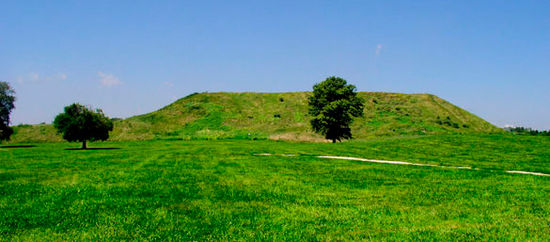
As the major centers, such as Cahokia, collapsed and the trade networks broke down, the regional styles diverged farther from the Braden Style and, from each other. During the ensuing centuries, the local traditions diverged into the religious beliefs and cosmologies of the different tribes known to exist at the time of European contact.

 Most S.E.C.C. imagery focuses on cosmology
Most S.E.C.C. imagery focuses on cosmology
and the supernatural beings who inhabit the cosmos. The cosmological map encompassed real, knowable locations, whether in this world or the supernatural reality of the Otherworld. S.E.C.C. iconography portrayed the cosmos in three levels. The Above World or Overworld, was the home of the Thunderers
, the Sun, Moon, and Morning Star or Red Horn / "He Who Wears Human Heads For Earrings" and represented Order and Stability. The Middle World was the Earth that humans live in. The Beneath World or Under World was a cold, dark place of Chaos that was home to the underwater panther
and Corn Mother or "Old Woman Who Never Dies". These three worlds were connected by an axis mundi
, usually portrayed as a cedar tree or a striped pole reaching from the Under World to the Over World. Each of the three levels also was believed to have its own sub-levels. Deeply ingrained in the world view was the concept of duality
and opposition. The beings of the Upper and Under realms were in constant opposition to each other. Ritual and ceremony were the means by which these powerful forces could be accessed and harnessed.
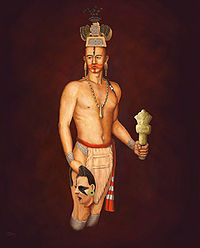 The falcon
The falcon
is one of the most conspicuous symbols of the S.E.C.C. It was simultaneously an avatar
of warriors and an object of supplication for a lengthy life, healthy family, and a long line of descendants. Its supernatural origin is placed in the Upperworld with a pantheon including the Sun, Moon, and Four Stars.
In Cahokia
the falcon imagery found elaborate figural expression. It is associated with warfare, high stakes gaming, and possibly family dynastic ambitions, symbolized by arrow flights and the rising of the pre-dawn morning star as metaphors for the succession of descendants into the future. Raptor imagery gained prominence during the Hopewell period, but attained its peak in the Braden Style of the early Mississippian period. It survived afterward in the Red Horn mythological cycle and native religion of the Ho-Chunk
(Winnebagos), Osage
, Ioway, and other plains Siouan peoples. In the Braden Style, the Birdman is divided into four categories.
Various motifs are associated with the Birdman, including the forked eye motif, columnella pendants, mace or club weapons, severed heads, chunkey
play (including chunkey stones, striped and broken chunkey sticks), bellows-shaped aprons, and bi-lobed arrow motifs.
mythic cycle of Mesoamerica
. Redhorn was known by many names, including "Morning Star", a reference to his celestial origin, and "He who is Struck with Deer Lungs," a possible reference to the Bi-Lobed Arrow Motif. In the episode associated with this name, Red Horn turns into an arrow to win a race. After winning the race, Redhorn creates heads on his earlobes and makes his hair into a long red braid. Thus he becomes known as "Redhorn" and as "He who has Human Heads as Earlobes".
In another episode, Redhorn and his friends are challenged by the Giants to play ball
(or possibly chunkey) with their lives staked on the outcome. The best Giant player was a woman with long red hair identical to Redhorn's. The little heads on Redhorn's ears caused her to laugh so much that it interfered with her game and the Giants lost. The Giants lost all the other contests as well. Then they challenged Redhorn and his friends to a wrestling match in which they threw all but Red Horn's friend Turtle. Since Redhorn and his fellow spirits lost two out of the three matches, they were all slain. The two wives of Redhorn were pregnant at the time of his death. The sons born to each have red hair, with the older one having heads where his earlobes should be, and the younger one having heads in place of his nipples. The older brother discovers where the Giants keep the heads of Redhorn and his friends. The two boys use their powers to steal the heads from the Giants, whom they wipe out almost completely. The boys bring back to life Redhorn, Storms as He Walks, and Turtle. In honor of this feat, Turtle and "Storms as He Walks" promise the boys special weapons.
In another episode, the sons of Redhorn decide to go on the warpath. The older brother asks "Storms as He Walks" for the Thunderbird War bundle. After some effort, it is produced, but the Thunderbirds demand that it have a case. A friend of the sons of Redhorn offers his own body as its case. The boys take the Thunderbird War bundle and with their followers go on a raid to the other side of the sky.
Many S.E.C.C. images seem to be of Red Horn, his companions, and his sons. The characters in the myth seem to be tied integrally to the calumet
(peace pipe) ceremony, and its association with kinship and adoption. In fact, the Bi-Lobed Arrow Motif may be a graphic depiction of the calumet. Other images found in S.E.C.C. art show figures with long-nosed god maskette
s on their ears and in place of their nipples.
myths, the serpent is described as a multi-headed monster with one green and one red horn, horns being a manifestation or marker of its power. In other myths, it is described as a one-eyed buffalo with one green and one red horn. The Piasa
of the Miami
s was painted on a bluff near present-day Alton, Illinois
. It was described as having the body of a panther, four legs, a human head, an impossibly long tail. and horns.
Mishibizhiw, the Ojibwa
underwater panther
, was a combination of rattlesnake
, cougar, deer
, and hawk
. Other native peoples also gave descriptions of the being, sometimes now referred to as the Spirit Otter, with the majority seeming to belong to one of two extremes, and a multitude in between.
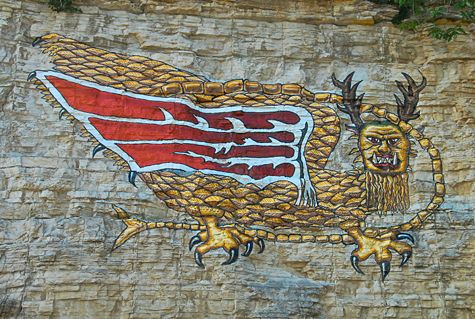
The Great Serpents, the great denizens of the Underworld, were described as powerful beings who were in constant antagonism with the forces of the Upper World, usually represented by the Thunderer
s (Birdmen or Falcon beings). Although men were to be careful of these beings, they could also be the source of great power. A Shawnee myth tells of the capture and dismemberment of Msi Kinepikwa. The pieces were distributed to the five septs of the tribe, who kept them in their sacred "medicine bundles".
, pottery
, carved stone
, and copper. Undoubtedly many other materials also were used, but haven't survived the intervening centuries. It may be judged by looking at the remaining artifacts that S.E.C.C. practitioners worked with feathers and designs woven into cloth, practiced body painting, and possibly tattoo
ing, as well as having pierced ears. One surviving painting found on a baked clay floor at the Wickliffe Mounds
site suggests they also painted designs in and on their dwellings. Paintings displaying S.E.C.C. imagery also have been found in caves, most notably Mud Glyph Cave
in Tennessee. Animal images, serpents, and warrior figures occur, as well as winged warriors, horned snakes, stylized birds, maces, and arrows. Their location underneath the Earth probably reflect aspects of Mississippian myth and cosmology concerning the (perhaps sacred) precincts beneath the earth.
Artifact (archaeology)
An artifact or artefact is "something made or given shape by man, such as a tool or a work of art, esp an object of archaeological interest"...
, iconography
Iconography
Iconography is the branch of art history which studies the identification, description, and the interpretation of the content of images. The word iconography literally means "image writing", and comes from the Greek "image" and "to write". A secondary meaning is the painting of icons in the...
, ceremonies
Ceremony
A ceremony is an event of ritual significance, performed on a special occasion. The word may be of Etruscan origin.-Ceremonial occasions:A ceremony may mark a rite of passage in a human life, marking the significance of, for example:* birth...
, and mythology
Mythology
The term mythology can refer either to the study of myths, or to a body or collection of myths. As examples, comparative mythology is the study of connections between myths from different cultures, whereas Greek mythology is the body of myths from ancient Greece...
of the Mississippian culture
Mississippian culture
The Mississippian culture was a mound-building Native American culture that flourished in what is now the Midwestern, Eastern, and Southeastern United States from approximately 800 CE to 1500 CE, varying regionally....
that coincided with their adoption of maize
Maize
Maize known in many English-speaking countries as corn or mielie/mealie, is a grain domesticated by indigenous peoples in Mesoamerica in prehistoric times. The leafy stalk produces ears which contain seeds called kernels. Though technically a grain, maize kernels are used in cooking as a vegetable...
agriculture and chiefdom
Chiefdom
A chiefdom is a political economy that organizes regional populations through a hierarchy of the chief.In anthropological theory, one model of human social development rooted in ideas of cultural evolution describes a chiefdom as a form of social organization more complex than a tribe or a band...
-level complex social organization from 1200 CE to 1650 CE. Contrary to popular belief, this development appears to have no direct links to Mesoamerica
Mesoamerica
Mesoamerica is a region and culture area in the Americas, extending approximately from central Mexico to Belize, Guatemala, El Salvador, Honduras, Nicaragua, and Costa Rica, within which a number of pre-Columbian societies flourished before the Spanish colonization of the Americas in the 15th and...
, but developed independently. This ceremonial complex represents a major component of the religion
Religion
Religion is a collection of cultural systems, belief systems, and worldviews that establishes symbols that relate humanity to spirituality and, sometimes, to moral values. Many religions have narratives, symbols, traditions and sacred histories that are intended to give meaning to life or to...
of the Mississippian peoples, and is one of the primary means by which their religion is understood.
Theories and names
Much of what is called a "complex" was in actuality, more of an "exchange network." This kind of network may be illustrated by a pair of shell gorgetShell gorget
A shell gorget is a Native American art form of polished, carved shell pendants worn around the neck. The gorgets are frequently engraved, and are sometimes highlighted with pigments, or fenestrated ....
s whose representation is so similar as to suggest that they were made by the same artist. One is from southeast Missouri
Missouri
Missouri is a US state located in the Midwestern United States, bordered by Iowa, Illinois, Kentucky, Tennessee, Arkansas, Oklahoma, Kansas and Nebraska. With a 2010 population of 5,988,927, Missouri is the 18th most populous state in the nation and the fifth most populous in the Midwest. It...
and the other from Spiro Mounds
Spiro Mounds
Spiro Mounds is an important pre-Columbian Caddoan Mississippian culture archaeological site located in present-day eastern Oklahoma in the United States. The site is located seven miles north of Spiro, and is the only prehistoric Native American archaeological site in Oklahoma open to the public...
in Oklahoma
Oklahoma
Oklahoma is a state located in the South Central region of the United States of America. With an estimated 3,751,351 residents as of the 2010 census and a land area of 68,667 square miles , Oklahoma is the 28th most populous and 20th-largest state...
. There are a number of other pairs of extremely similar gorgets that serve to link sites across the entire Southeast. The social organization of the Mississippian culture was based on warfare, which may be identified by exotic motifs and symbols and by costly raw materials such as conch
Conch
A conch is a common name which is applied to a number of different species of medium-sized to large sea snails or their shells, generally those which are large and have a high spire and a siphonal canal....
es from Florida
Florida
Florida is a state in the southeastern United States, located on the nation's Atlantic and Gulf coasts. It is bordered to the west by the Gulf of Mexico, to the north by Alabama and Georgia and to the east by the Atlantic Ocean. With a population of 18,801,310 as measured by the 2010 census, it...
, copper
Copper
Copper is a chemical element with the symbol Cu and atomic number 29. It is a ductile metal with very high thermal and electrical conductivity. Pure copper is soft and malleable; an exposed surface has a reddish-orange tarnish...
from the southeast, lead
Lead
Lead is a main-group element in the carbon group with the symbol Pb and atomic number 82. Lead is a soft, malleable poor metal. It is also counted as one of the heavy metals. Metallic lead has a bluish-white color after being freshly cut, but it soon tarnishes to a dull grayish color when exposed...
from northern Illinois
Illinois
Illinois is the fifth-most populous state of the United States of America, and is often noted for being a microcosm of the entire country. With Chicago in the northeast, small industrial cities and great agricultural productivity in central and northern Illinois, and natural resources like coal,...
and Iowa
Iowa
Iowa is a state located in the Midwestern United States, an area often referred to as the "American Heartland". It derives its name from the Ioway people, one of the many American Indian tribes that occupied the state at the time of European exploration. Iowa was a part of the French colony of New...
, pottery from Tennessee
Tennessee
Tennessee is a U.S. state located in the Southeastern United States. It has a population of 6,346,105, making it the nation's 17th-largest state by population, and covers , making it the 36th-largest by total land area...
, stone tool sources from Kansas
Kansas
Kansas is a US state located in the Midwestern United States. It is named after the Kansas River which flows through it, which in turn was named after the Kansa Native American tribe, which inhabited the area. The tribe's name is often said to mean "people of the wind" or "people of the south...
, Texas
Texas
Texas is the second largest U.S. state by both area and population, and the largest state by area in the contiguous United States.The name, based on the Caddo word "Tejas" meaning "friends" or "allies", was applied by the Spanish to the Caddo themselves and to the region of their settlement in...
, and southern Illinois
Mill Creek chert
Mill Creek chert is a type of chert found in Southern Illinois and heavily exploited by members of the Mississippian culture . Artifacts made from this material are found in archeological sites throughout the American Midwest and Southeast. It is named for a village and stream near the quarrys,...
. Such objects occur in elite
Elite
Elite refers to an exceptional or privileged group that wields considerable power within its sphere of influence...
burial
Burial
Burial is the act of placing a person or object into the ground. This is accomplished by excavating a pit or trench, placing an object in it, and covering it over.-History:...
s, together with war axe
Axe
The axe, or ax, is an implement that has been used for millennia to shape, split and cut wood; to harvest timber; as a weapon; and as a ceremonial or heraldic symbol...
s, maces, and other weapons. These warrior symbols occur alongside other artifacts which bear exotic cosmic imagery, depicting animals, humans, and mythic beasts. This symbolic imagery bound together warfare, cosmology
Cosmology
Cosmology is the discipline that deals with the nature of the Universe as a whole. Cosmologists seek to understand the origin, evolution, structure, and ultimate fate of the Universe at large, as well as the natural laws that keep it in order...
, and nobility into a coherent whole. Some of these categories of artifacts were used as markers of chiefly office, which varied from one location to another. The term reflects a complex, highly variable set of religious mechanisms that supported the authority of local chiefs
Tribal chief
A tribal chief is the leader of a tribal society or chiefdom. Tribal societies with social stratification under a single leader emerged in the Neolithic period out of earlier tribal structures with little stratification, and they remained prevalent throughout the Iron Age.In the case of ...
.
The S.E.C.C. was first defined in 1945 by Antonio Waring and Preston Holder
Preston Holder
Preston Holder was an American archaeologist and photographer.In 1930 he entered the University of California, Berkeley, to study anthropology. While there he met photographer Willard Van Dyke after writing an assignment about his photographs...
as a series of four lists of traits which they categorized as the Southeastern (centered) Ceremonial Complex. Their concept was of a complex of a specific cult manifestation that originated with Muskogean speakers
Muskogean languages
Muskogean is an indigenous language family of the Southeastern United States. Though there is an ongoing debate concerning their interrelationships, the Muskogean languages are generally divided into two branches, Eastern Muskogean and Western Muskogean...
in the southern United States. Since then scholars have expanded the original definition, while using its trait lists as a foundation for critical analysis of the entire concept.
In 1989 scholars proposed a more archaeologically based definition for defining the Mississippian artistic tradition. Jon Muller of Southern Illinois University
Southern Illinois University
Southern Illinois University is a state university system based in Carbondale, Illinois, in the Southern Illinois region of the state, with multiple campuses...
proposes the classification of the complex into five horizons, with each as a discrete tradition defined by the origin of specific motifs and ritual objects, and the specific developments in long-distance exchange and political structures.
Mississippian Ideological Interaction Sphere horizons
| Horizons | Dates | Markers |
|---|---|---|
| Developmental Cult Period | 900 - 1150 CE | Long-nosed god shell and copper masks Long-nosed god maskette Long-nosed god maskettes are artifacts made from bone, copper and marine shells associated with the Mississippian culture and found in archaeological sites in the American Midwest and Southeast. They are small shield-shaped faces with squared-off foreheads, circular eyes, and large noses of... , and "square cross" symbol appears |
| Southern Cult Period | 1250 - 1350 CE | Apogee of the horizon, bi-lobed arrows, striped pole, baton or mace, fringed apron, chunkey player, and ogee appear |
| Attenuated Cult Period | 1350 - 1450 CE | Trade networks break down; motifs previously on exotic materials begin to appear on pottery and other local products |
| Post Southern Cult Period | 1450 - 1550 CE | Rise of a large number of regional artistic traditions that manifest distinct stylistic differences |
| Historic Period | 1550 CE onward | Termination of the ideological traditions, as well as the complex; rise of tribal societies of the European contact period |
With the redefinition of the complex, some have suggested a new name be chosen, one that exemplifies the new understanding of the large body of art symbols classified as the S.E.C.C. Participants of a decade-long series of conferences held at Texas State University have proposed the terms "Mississippian Ideological Interaction Sphere" or "M.I.I.S." and "Mississippian Art and Ceremonial Complex" or "M.A.C.C." Present theories suggest that the complex developed from pre-existing beliefs spread over the midwest and southeast by the Hopewell Interaction Sphere from 100 BCE to 500 CE.
The major expression of the complex developed at the Cahokia
Cahokia
Cahokia Mounds State Historic Site is the area of an ancient indigenous city located in the American Bottom floodplain, between East Saint Louis and Collinsville in south-western Illinois, across the Mississippi River from St. Louis, Missouri. The site included 120 human-built earthwork mounds...
site, known as the Braden Style, and corresponds with the Southern Cult Period horizon of Muller. Other regional styles developed as a result of the fusion of ideas borrowed from the Braden Style and pre-existing local expressions of post-Hopewellian traditions.
Projected development of M.A.C.C. styles

| Classic Braden Cahokia Cahokia Cahokia Mounds State Historic Site is the area of an ancient indigenous city located in the American Bottom floodplain, between East Saint Louis and Collinsville in south-western Illinois, across the Mississippi River from St. Louis, Missouri. The site included 120 human-built earthwork mounds... |
Late Braden Cahokia |
Late Braden | |
| Hemphill Moundville Moundville Archaeological Site Moundville Archaeological Site, also known as the Moundville Archaeological Park, is a Mississippian site on the Black Warrior River in Hale County, near the town of Tuscaloosa, Alabama... |
|||
| Craig ASpiro Spiro Mounds Spiro Mounds is an important pre-Columbian Caddoan Mississippian culture archaeological site located in present-day eastern Oklahoma in the United States. The site is located seven miles north of Spiro, and is the only prehistoric Native American archaeological site in Oklahoma open to the public... |
Craig BSpiro | Craig CSpiro | |
| HightowerEtowah Etowah Indian Mounds Etowah Indian Mounds is a archaeological site in Bartow County, Georgia south of Cartersville, in the United States. Built and occupied in three phases, from 1000–1550 CE, the prehistoric site is located on the north shore of the Etowah River. Etowah Indian Mounds Historic Site is a designated... |
|||
As the major centers, such as Cahokia, collapsed and the trade networks broke down, the regional styles diverged farther from the Braden Style and, from each other. During the ensuing centuries, the local traditions diverged into the religious beliefs and cosmologies of the different tribes known to exist at the time of European contact.
Cosmology


Cosmology
Cosmology is the discipline that deals with the nature of the Universe as a whole. Cosmologists seek to understand the origin, evolution, structure, and ultimate fate of the Universe at large, as well as the natural laws that keep it in order...
and the supernatural beings who inhabit the cosmos. The cosmological map encompassed real, knowable locations, whether in this world or the supernatural reality of the Otherworld. S.E.C.C. iconography portrayed the cosmos in three levels. The Above World or Overworld, was the home of the Thunderers
Thunderbird (mythology)
The Thunderbird is a legendary creature in certain North American indigenous peoples' history and culture. It is considered a "supernatural" bird of power and strength...
, the Sun, Moon, and Morning Star or Red Horn / "He Who Wears Human Heads For Earrings" and represented Order and Stability. The Middle World was the Earth that humans live in. The Beneath World or Under World was a cold, dark place of Chaos that was home to the underwater panther
Underwater panther
An Underwater panther is a powerful creature in the mythological traditions of some Native American tribes, particularly Anishinaabe tribes, the Odawa, Ojibwe, and Potawatomi, of the Great Lakes region of Canada and the United States...
and Corn Mother or "Old Woman Who Never Dies". These three worlds were connected by an axis mundi
Axis mundi
The axis mundi , in religion or mythology, is the world center and/or the connection between heaven and Earth. As the celestial pole and geographic pole, it expresses a point of connection between sky and earth where the four compass directions meet...
, usually portrayed as a cedar tree or a striped pole reaching from the Under World to the Over World. Each of the three levels also was believed to have its own sub-levels. Deeply ingrained in the world view was the concept of duality
Dualistic cosmology
Dualistic cosmology is a collective term. Many variant myths and creation motifs are so described in ethnographic and anthropological literature...
and opposition. The beings of the Upper and Under realms were in constant opposition to each other. Ritual and ceremony were the means by which these powerful forces could be accessed and harnessed.
Motifs
Many common motifs in S.E.C.C. artwork are locative symbols that help determine where the action takes place and where the beings portrayed originated.| Motif | Image | Description |
|---|---|---|
| Petaloid Motif |  |
This motif derives its name from its resemblance to flower petals, but it most likely represents feathers. A Petaloid placed around individuals, objects, or supernatural beings denotes its location as "celestial". |
| Quincunx Quincunx A quincunx is a geometric pattern consisting of five points arranged in a cross, that is five coplanar points, four of them forming a square or rectangle and a fifth at its center... or Cross in Circle Sun cross The sun cross, also known as the wheel cross, Odin's cross, or Woden's cross, a cross inside a circle, is a common symbol in artifacts of the Americas and Prehistoric Europe, particularly during the Neolithic to Bronze Age periods.-Stone Age:... Motif |
 |
The Cross in Circle Motif is prevalent in most Native American religions. It has solar connotations Sun cross The sun cross, also known as the wheel cross, Odin's cross, or Woden's cross, a cross inside a circle, is a common symbol in artifacts of the Americas and Prehistoric Europe, particularly during the Neolithic to Bronze Age periods.-Stone Age:... and usually symbolizes the sacred fire that exists in the Middle World. A Cross in Circle Motif combined with a Petaloid Motif symbolized the Above World. |
| Swastika Swastika The swastika is an equilateral cross with its arms bent at right angles, in either right-facing form in counter clock motion or its mirrored left-facing form in clock motion. Earliest archaeological evidence of swastika-shaped ornaments dates back to the Indus Valley Civilization of Ancient... in Circle Motif |
 |
A swastika is a variation of the Cross in Circle Motif, symbolizing the creative, generative power of the Underworld. |
| Forked Eye Surround Motif |  |
Beings wearing the Forked Eye Surround Motif are understood to reside in the Above World. It is derived from the eye markings of the Peregrine Falcon Peregrine Falcon The Peregrine Falcon , also known as the Peregrine, and historically as the Duck Hawk in North America, is a widespread bird of prey in the family Falconidae. A large, crow-sized falcon, it has a blue-gray back, barred white underparts, and a black head and "moustache"... . |
| Eye Surround Motif |  |
Beings wearing the Eye Surround Motif resided in the Under World. |
| Ogee Motif |  |
The Ogee Motif symbolized portals into the Underworld. It appears frequently on Under World Deities. It may symbolize caves, may be derived from representations of female genitalia, or a human eye motif. |
| Striped-Center-Pole Motif |  |
The Cedar Tree and Striped Pole Motif represent the Axis Mundi Axis mundi The axis mundi , in religion or mythology, is the world center and/or the connection between heaven and Earth. As the celestial pole and geographic pole, it expresses a point of connection between sky and earth where the four compass directions meet... or world tree, a central axis on which all the worlds rotated and were connected. It would have had alternating bands of red and white. It is often augmented with raccoon skin bundles, Ogee Motifs, and anthropomorphic heads. |
| Trilobed Motif |  |
The Tri-lobed Motif functioned as a serpent marking and may have symbolized a supernaturals ability to travel from the Lower World to the Upper World. |
| Bi-Lobed Arrow Motif |  |
The Bi-Lobed Arrow Motif is often seen in the headdresses of the warriors/birdmen/chunkey players. A complex symbol, it is a graphic representation of a bow and arrow, an atlatl Atlatl An atlatl or spear-thrower is a tool that uses leverage to achieve greater velocity in dart-throwing.It consists of a shaft with a cup or a spur at the end that supports and propels the butt of the dart. The atlatl is held in one hand, gripped near the end farthest from the cup... , or possibly a calumet. In the Red Horn Red Horn (man) Red Horn is a culture hero in Siouan oral traditions, specifically of the Ioway and Hocąk nations. Only in Hocąk literature is he known as "Red Horn" , but among the Ioway and Hocągara both, he is known by one of his variant names, "He Who Wears Faces on His Ears"... Cycle, Red Horn is also called "He who gets hit with deer lungs", which may be a euphemism or an allusion to the fact that deer lungs with the trachea attached, resemble the graphic depiction of the Bi-Lobed Arrow. It may symbolize kinship and adoption rituals related to social hierarchies. Repoussé Repoussé and chasing Repoussé or repoussage is a metalworking technique in which a malleable metal is ornamented or shaped by hammering from the reverse side to create a design in low relief. There are few techniques that offer such diversity of expression while still being relatively economical... copper examples have been found in Mississippian sites. |
| The Hand and Eye Hamsa Hamsa or Khamsa can refer to:*Arabic "five, quintet"** Ḫamsa, a Near Eastern symbol often used as a protective amulet** a commonly used alternative name for the Panj Ganj or Quinary, ie quintet of Nizami's first five great epics*Sanskrit ... Motif |
 |
The Hand and Eye Motif is a human hand with an eye gazing out from the palm, yet another symbol of deity. It was one of the most common motifs in Mississippian symbolism and may be related to the Ogee Motif, suggesting it represents a portal to the Otherworld. |
| Mace Motif |  |
The Mace Motif usually is associated with the warrior image and may be combined with other motifs, especially the Cross in Circle Motif. It is a graphic representation of a war club or ceremonial mace Ceremonial mace The ceremonial mace is a highly ornamented staff of metal or wood, carried before a sovereign or other high official in civic ceremonies by a mace-bearer, intended to represent the official's authority. The mace, as used today, derives from the original mace used as a weapon... , such as the chipped flint and ground stone versions found throughout the southeast. |
| Columnella Pendant Motif |  |
The Columnella Pendant is a graphic representation of the longitudinal center columnella of a whelk Whelk Whelk, also spelled welk or even "wilks", is a common name used to mean one or more kinds of sea snail. The species, genera and families referred to using this common name vary a great deal from one geographic area to another... shell. Because of the association of whelk shells with the black drink ceremony Black drink Black drink was the name given by colonists to a ritual beverage called Asi, brewed by Native Americans in the Southeastern United States... , it is theorized that this symbol is associated with it as well. |
Birdman

Peregrine Falcon
The Peregrine Falcon , also known as the Peregrine, and historically as the Duck Hawk in North America, is a widespread bird of prey in the family Falconidae. A large, crow-sized falcon, it has a blue-gray back, barred white underparts, and a black head and "moustache"...
is one of the most conspicuous symbols of the S.E.C.C. It was simultaneously an avatar
Avatar
In Hinduism, an avatar is a deliberate descent of a deity to earth, or a descent of the Supreme Being and is mostly translated into English as "incarnation," but more accurately as "appearance" or "manifestation"....
of warriors and an object of supplication for a lengthy life, healthy family, and a long line of descendants. Its supernatural origin is placed in the Upperworld with a pantheon including the Sun, Moon, and Four Stars.
In Cahokia
Cahokia
Cahokia Mounds State Historic Site is the area of an ancient indigenous city located in the American Bottom floodplain, between East Saint Louis and Collinsville in south-western Illinois, across the Mississippi River from St. Louis, Missouri. The site included 120 human-built earthwork mounds...
the falcon imagery found elaborate figural expression. It is associated with warfare, high stakes gaming, and possibly family dynastic ambitions, symbolized by arrow flights and the rising of the pre-dawn morning star as metaphors for the succession of descendants into the future. Raptor imagery gained prominence during the Hopewell period, but attained its peak in the Braden Style of the early Mississippian period. It survived afterward in the Red Horn mythological cycle and native religion of the Ho-Chunk
Ho-Chunk
The Ho-Chunk, also known as Winnebago, are a tribe of Native Americans, native to what is now Wisconsin and Illinois. There are two federally recognized Ho-Chunk tribes, the Ho-Chunk Nation of Wisconsin and Winnebago Tribe of Nebraska....
(Winnebagos), Osage
Osage Nation
The Osage Nation is a Native American Siouan-language tribe in the United States that originated in the Ohio River valley in present-day Kentucky. After years of war with invading Iroquois, the Osage migrated west of the Mississippi River to their historic lands in present-day Arkansas, Missouri,...
, Ioway, and other plains Siouan peoples. In the Braden Style, the Birdman is divided into four categories.
- Falcon Dancers with wings.
- ChunkeyChunkeyChunkey is a game of Native American origin. It was played by rolling disc shaped stones across the ground and throwing spears at them in an attempt to place the spear as close to the stopped stone as possible...
players / warriors with wings. - Club-wielding wingless warriors.
- Dancing wingless warriors / chunkey players
Various motifs are associated with the Birdman, including the forked eye motif, columnella pendants, mace or club weapons, severed heads, chunkey
Chunkey
Chunkey is a game of Native American origin. It was played by rolling disc shaped stones across the ground and throwing spears at them in an attempt to place the spear as close to the stopped stone as possible...
play (including chunkey stones, striped and broken chunkey sticks), bellows-shaped aprons, and bi-lobed arrow motifs.
Red Horn and his sons
The Red Horn Mythic Cycle is from the Ho Chunk, or Winnebago people. The mythic cycle of Red Horn and his sons has certain analogies with the Hero TwinsMaya Hero Twins
The Maya Hero Twins are the central figures of a narrative included within the colonial Quiché document called Popol Vuh, and constituting the oldest Maya myth to have been preserved in its entirety. Called Hunahpu and Xbalanque in Quiché, the Twins have also been identified in the art of the...
mythic cycle of Mesoamerica
Mesoamerica
Mesoamerica is a region and culture area in the Americas, extending approximately from central Mexico to Belize, Guatemala, El Salvador, Honduras, Nicaragua, and Costa Rica, within which a number of pre-Columbian societies flourished before the Spanish colonization of the Americas in the 15th and...
. Redhorn was known by many names, including "Morning Star", a reference to his celestial origin, and "He who is Struck with Deer Lungs," a possible reference to the Bi-Lobed Arrow Motif. In the episode associated with this name, Red Horn turns into an arrow to win a race. After winning the race, Redhorn creates heads on his earlobes and makes his hair into a long red braid. Thus he becomes known as "Redhorn" and as "He who has Human Heads as Earlobes".
In another episode, Redhorn and his friends are challenged by the Giants to play ball
History of Lacrosse
Lacrosse has its origins in a tribal game played by all eastern Woodlands Native Americans and by some Plains Indians tribes in what is now Canada. The game has been modernized extensively by European immigrants to create its current form....
(or possibly chunkey) with their lives staked on the outcome. The best Giant player was a woman with long red hair identical to Redhorn's. The little heads on Redhorn's ears caused her to laugh so much that it interfered with her game and the Giants lost. The Giants lost all the other contests as well. Then they challenged Redhorn and his friends to a wrestling match in which they threw all but Red Horn's friend Turtle. Since Redhorn and his fellow spirits lost two out of the three matches, they were all slain. The two wives of Redhorn were pregnant at the time of his death. The sons born to each have red hair, with the older one having heads where his earlobes should be, and the younger one having heads in place of his nipples. The older brother discovers where the Giants keep the heads of Redhorn and his friends. The two boys use their powers to steal the heads from the Giants, whom they wipe out almost completely. The boys bring back to life Redhorn, Storms as He Walks, and Turtle. In honor of this feat, Turtle and "Storms as He Walks" promise the boys special weapons.
In another episode, the sons of Redhorn decide to go on the warpath. The older brother asks "Storms as He Walks" for the Thunderbird War bundle. After some effort, it is produced, but the Thunderbirds demand that it have a case. A friend of the sons of Redhorn offers his own body as its case. The boys take the Thunderbird War bundle and with their followers go on a raid to the other side of the sky.
Many S.E.C.C. images seem to be of Red Horn, his companions, and his sons. The characters in the myth seem to be tied integrally to the calumet
Calumet (pipe)
A Calumet is a ceremonial smoking pipe used by some Native American Nations. Traditionally it has been smoked to seal a covenant or treaty, or to offer prayers in a religious ceremony.- Etymology :...
(peace pipe) ceremony, and its association with kinship and adoption. In fact, the Bi-Lobed Arrow Motif may be a graphic depiction of the calumet. Other images found in S.E.C.C. art show figures with long-nosed god maskette
Long-nosed god maskette
Long-nosed god maskettes are artifacts made from bone, copper and marine shells associated with the Mississippian culture and found in archaeological sites in the American Midwest and Southeast. They are small shield-shaped faces with squared-off foreheads, circular eyes, and large noses of...
s on their ears and in place of their nipples.
Great Serpent
The Great Serpent (or Horned Serpent) is the most well-known mythological figure from the S.E.C.C. Its roots go back to Hopewell times, if not earlier. It usually is described as horned and winged, although the wings are more an indicator of its celestial origin than an essential form of the creature. In some versions of ShawneeShawnee
The Shawnee, Shaawanwaki, Shaawanooki and Shaawanowi lenaweeki, are an Algonquian-speaking people native to North America. Historically they inhabited the areas of Ohio, Virginia, West Virginia, Western Maryland, Kentucky, Indiana, and Pennsylvania...
myths, the serpent is described as a multi-headed monster with one green and one red horn, horns being a manifestation or marker of its power. In other myths, it is described as a one-eyed buffalo with one green and one red horn. The Piasa
Piasa
The Piasa or Piasa Bird is a Native American dragon depicted in one of two murals painted by Native Americans on bluffs above the Mississippi River. Its original location was at the end of a chain of limestone bluffs in Madison County, Illinois at present-day Alton, Illinois...
of the Miami
Miami tribe
The Miami are a Native American nation originally found in what is now Indiana, southwest Michigan, and western Ohio. The Miami Tribe of Oklahoma is the only federally recognized tribe of Miami Indians in the United States...
s was painted on a bluff near present-day Alton, Illinois
Alton, Illinois
Alton is a city on the Mississippi River in Madison County, Illinois, United States, about north of St. Louis, Missouri. The population was 27,865 at the 2010 census. It is a part of the Metro-East region of the Greater St. Louis metropolitan area in Southern Illinois...
. It was described as having the body of a panther, four legs, a human head, an impossibly long tail. and horns.
Mishibizhiw, the Ojibwa
Ojibwa
The Ojibwe or Chippewa are among the largest groups of Native Americans–First Nations north of Mexico. They are divided between Canada and the United States. In Canada, they are the third-largest population among First Nations, surpassed only by Cree and Inuit...
underwater panther
Underwater panther
An Underwater panther is a powerful creature in the mythological traditions of some Native American tribes, particularly Anishinaabe tribes, the Odawa, Ojibwe, and Potawatomi, of the Great Lakes region of Canada and the United States...
, was a combination of rattlesnake
Rattlesnake
Rattlesnakes are a group of venomous snakes of the genera Crotalus and Sistrurus of the subfamily Crotalinae . There are 32 known species of rattlesnake, with between 65-70 subspecies, all native to the Americas, ranging from southern Alberta and southern British Columbia in Canada to Central...
, cougar, deer
Deer
Deer are the ruminant mammals forming the family Cervidae. Species in the Cervidae family include white-tailed deer, elk, moose, red deer, reindeer, fallow deer, roe deer and chital. Male deer of all species and female reindeer grow and shed new antlers each year...
, and hawk
Hawk
The term hawk can be used in several ways:* In strict usage in Australia and Africa, to mean any of the species in the subfamily Accipitrinae, which comprises the genera Accipiter, Micronisus, Melierax, Urotriorchis and Megatriorchis. The large and widespread Accipiter genus includes goshawks,...
. Other native peoples also gave descriptions of the being, sometimes now referred to as the Spirit Otter, with the majority seeming to belong to one of two extremes, and a multitude in between.
Distribution of belief in the two major forms of the Great Serpent

| Underwater Panther Underwater panther An Underwater panther is a powerful creature in the mythological traditions of some Native American tribes, particularly Anishinaabe tribes, the Odawa, Ojibwe, and Potawatomi, of the Great Lakes region of Canada and the United States... |
Both or in between versions | Horned Serpent |
|---|---|---|
| Winnebago Ho-Chunk The Ho-Chunk, also known as Winnebago, are a tribe of Native Americans, native to what is now Wisconsin and Illinois. There are two federally recognized Ho-Chunk tribes, the Ho-Chunk Nation of Wisconsin and Winnebago Tribe of Nebraska.... |
Dakota Sioux The Sioux are Native American and First Nations people in North America. The term can refer to any ethnic group within the Great Sioux Nation or any of the nation's many language dialects... |
Micmac |
| Ojibwa Ojibwa The Ojibwe or Chippewa are among the largest groups of Native Americans–First Nations north of Mexico. They are divided between Canada and the United States. In Canada, they are the third-largest population among First Nations, surpassed only by Cree and Inuit... |
Mandan | Passamaquoddy Passamaquoddy The Passamaquoddy are the First Nations people who live in northeastern North America, primarily in Maine and New Brunswick.... |
| Arikara Arikara Arikara are a group of Native Americans in North Dakota... |
Hidatsa Hidatsa The Hidatsa are a Siouan people, a part of the Three Affiliated Tribes. The Hidatsa's autonym is Hiraacá. According to the tribal tradition, the word hiraacá derives from the word "willow"; however, the etymology is not transparent and the similarity to mirahací ‘willows’ inconclusive... |
Penobscot |
| Iroqouis | Cheyenne Cheyenne Cheyenne are a Native American people of the Great Plains, who are of the Algonquian language family. The Cheyenne Nation is composed of two united tribes, the Só'taeo'o and the Tsétsêhéstâhese .The Cheyenne are thought to have branched off other tribes of Algonquian stock inhabiting lands... |
Malecite |
| Omaha Omaha (tribe) The Omaha are a federally recognized Native American nation which lives on the Omaha Reservation in northeastern Nebraska and western Iowa, United States... |
Delaware Lenape The Lenape are an Algonquian group of Native Americans of the Northeastern Woodlands. They are also called Delaware Indians. As a result of the American Revolutionary War and later Indian removals from the eastern United States, today the main groups live in Canada, where they are enrolled in the... |
Huron |
| Miami | Sauk | Kickapoo |
| Ponca Ponca The Ponca are a Native American people of the Dhegihan branch of the Siouan-language group. There are two federally recognized Ponca tribes: the Ponca Tribe of Nebraska and the Ponca Tribe of Indians of Oklahoma... |
Menomini | Cherokee Cherokee The Cherokee are a Native American people historically settled in the Southeastern United States . Linguistically, they are part of the Iroquoian language family... |
| Shawnee Shawnee The Shawnee, Shaawanwaki, Shaawanooki and Shaawanowi lenaweeki, are an Algonquian-speaking people native to North America. Historically they inhabited the areas of Ohio, Virginia, West Virginia, Western Maryland, Kentucky, Indiana, and Pennsylvania... |
Muskogee | Koasati |
| Natchez Natchez people The Natchez are a Native American people who originally lived in the Natchez Bluffs area, near the present-day city of Natchez, Mississippi. They spoke a language isolate that has no known close relatives, although it may be very distantly related to the Muskogean languages of the Creek... |
Tunica Tunica-Biloxi The modern Tunica-Biloxi tribe live in Mississippi and east central Louisiana. The modern tribe is composed of descendants of Tunica, Biloxi , Ofo , Avoyel , and Muskogean Choctaw. They speak mostly English and French... |
Alabama Alabama (people) The Alabama or Alibamu are a Southeastern culture people of Native Americans, originally from Mississippi... |
| Illinois Illiniwek The Illinois Confederation, sometimes referred to as the Illiniwek or Illini, were a group of twelve to thirteen Native American tribes in the upper Mississippi River valley of North America... |
Fox | Caddo Caddo The Caddo Nation is a confederacy of several Southeastern Native American tribes, who traditionally inhabited much of what is now East Texas, northern Louisiana and portions of southern Arkansas and Oklahoma. Today the Caddo Nation of Oklahoma is a cohesive tribe with its capital at Binger, Oklahoma... |
The Great Serpents, the great denizens of the Underworld, were described as powerful beings who were in constant antagonism with the forces of the Upper World, usually represented by the Thunderer
Thunderbird (mythology)
The Thunderbird is a legendary creature in certain North American indigenous peoples' history and culture. It is considered a "supernatural" bird of power and strength...
s (Birdmen or Falcon beings). Although men were to be careful of these beings, they could also be the source of great power. A Shawnee myth tells of the capture and dismemberment of Msi Kinepikwa. The pieces were distributed to the five septs of the tribe, who kept them in their sacred "medicine bundles".
Artifacts with S.E.C.C. imagery
S.E.C.C. motifs have been found on a variety of non-perishable materials, including shellShell gorget
A shell gorget is a Native American art form of polished, carved shell pendants worn around the neck. The gorgets are frequently engraved, and are sometimes highlighted with pigments, or fenestrated ....
, pottery
Mississippian culture pottery
Mississippian culture pottery is the ceramic tradition of the Mississippian culture found as artifacts in archaeological sites in the American Midwest and Southeast. It is often characterized by the adoption and use of riverine shell-tempering agents in the clay paste. Shell tempering is one of...
, carved stone
Mississippian stone statuary
The Mississippian stone statuary are artifacts of polished stone in the shape of human figurines made by members of the Mississippian culture and found in archaeological sites in the American Midwest and Southeast...
, and copper. Undoubtedly many other materials also were used, but haven't survived the intervening centuries. It may be judged by looking at the remaining artifacts that S.E.C.C. practitioners worked with feathers and designs woven into cloth, practiced body painting, and possibly tattoo
Tattoo
A tattoo is made by inserting indelible ink into the dermis layer of the skin to change the pigment. Tattoos on humans are a type of body modification, and tattoos on other animals are most commonly used for identification purposes...
ing, as well as having pierced ears. One surviving painting found on a baked clay floor at the Wickliffe Mounds
Wickliffe Mounds
Wickliffe Mounds is a prehistoric, Mississippian culture archaeological site located in Ballard County, Kentucky, just outside the town of Wickliffe, about three miles from the confluence of the Ohio and Mississippi rivers. Archaeology investigations have linked the site with others along the Ohio...
site suggests they also painted designs in and on their dwellings. Paintings displaying S.E.C.C. imagery also have been found in caves, most notably Mud Glyph Cave
Dunbar Cave State Park
Dunbar Cave State Park is a 110 acre park in Clarksville, Tennessee, situated around Dunbar Cave. Dunbar Cave is the 280th largest cave complex in the world, stretching 8.067 miles inward. In front of the cave entrance is a large concrete poured structure with three distinct arches...
in Tennessee. Animal images, serpents, and warrior figures occur, as well as winged warriors, horned snakes, stylized birds, maces, and arrows. Their location underneath the Earth probably reflect aspects of Mississippian myth and cosmology concerning the (perhaps sacred) precincts beneath the earth.
| Motif | Image 1 | Image 2 | Image 3 | Image 4 | Image 5 |
|---|---|---|---|---|---|
| Engraved Shell |  |
 |
 |
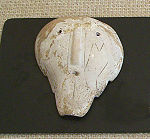 |
|
| Ceramics |  |
 |
 |
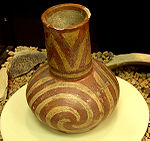 |
|
| Stone |  |
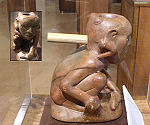 |
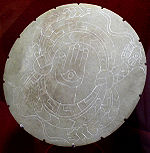 |
 |
|
| Copper | 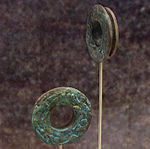 |
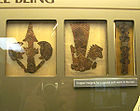 |
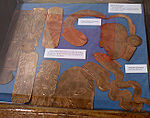 |
 |
 |
Sites associated with the Southeastern Ceremonial Complex
- Alligator Effigy Mound
- Angel MoundsAngel MoundsAngel Mounds State Historic Site is located on the Ohio River in Vanderburgh and Warrick Counties eight miles southeast of Evansville and just upriver of the confluence of the Green and Ohio rivers. Administered by the Indiana Department of Natural Resources, Division of Indiana State Museums...
- CahokiaCahokiaCahokia Mounds State Historic Site is the area of an ancient indigenous city located in the American Bottom floodplain, between East Saint Louis and Collinsville in south-western Illinois, across the Mississippi River from St. Louis, Missouri. The site included 120 human-built earthwork mounds...
- Castalian Springs Mound SiteCastalian Springs Mound SiteThe Castalian Springs Mound Site is a Mississippian culture archaeological site located near the small unincorporated community of Castalian Springs in Sumner County, Tennessee. The site was first excavated in the 1890s and again as recently as the 2005 to 2011 archaeological field school led by...
- Etowah Indian MoundsEtowah Indian MoundsEtowah Indian Mounds is a archaeological site in Bartow County, Georgia south of Cartersville, in the United States. Built and occupied in three phases, from 1000–1550 CE, the prehistoric site is located on the north shore of the Etowah River. Etowah Indian Mounds Historic Site is a designated...
- Kincaid Mounds State Historic SiteKincaid Mounds State Historic SiteThe Kincaid Mounds Historic Site, circa 1050-1400 CE, was among the largest prehistoric Mississippian culture chiefdom centers, located at the southern tip of present day U.S. state of Illinois...
- Mangum Mound SiteMangum Mound SiteMangum Mound Site is an archaeological site of the Plaquemine culture in Claiborne County, Mississippi. It is located at milepost 45.7 on the Natchez Trace Parkway. Two very rare Mississippian culture repoussé copper plates have been discovered during excavations of the site...
- Moundville Archaeological SiteMoundville Archaeological SiteMoundville Archaeological Site, also known as the Moundville Archaeological Park, is a Mississippian site on the Black Warrior River in Hale County, near the town of Tuscaloosa, Alabama...
- Ocmulgee National MonumentOcmulgee National MonumentOcmulgee National Monument preserves traces of over ten millennia of Southeastern Native American culture, including major earthworks built more than 1,000 years ago by Mississippian culture peoples: the Great Temple and other ceremonial mounds, a burial mound, and defensive trenches...
- Serpent MoundSerpent MoundThe Great Serpent Mound is a -long, three-foot-high prehistoric effigy mound located on a plateau of the Serpent Mound crater along Ohio Brush Creek in Adams County, Ohio. Maintained within a park by the Ohio Historical Society, it has been designated a National Historic Landmark by the United...
- Spiro MoundsSpiro MoundsSpiro Mounds is an important pre-Columbian Caddoan Mississippian culture archaeological site located in present-day eastern Oklahoma in the United States. The site is located seven miles north of Spiro, and is the only prehistoric Native American archaeological site in Oklahoma open to the public...
- Town Creek Indian MoundTown Creek Indian Mound-External links:*, North Carolina Historic Sites...
- Wickliffe MoundsWickliffe MoundsWickliffe Mounds is a prehistoric, Mississippian culture archaeological site located in Ballard County, Kentucky, just outside the town of Wickliffe, about three miles from the confluence of the Ohio and Mississippi rivers. Archaeology investigations have linked the site with others along the Ohio...
External links
- http://staff.jccc.net/scorbett01/Archaeology/chapter_12and13.htm

